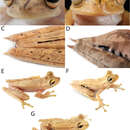Boana almendarizae: Brief Summary
provided by wikipedia EN
Boana almendarizae, or Almendariz's tree frog, is a frog in the family Hylidae endemic to Ecuador. Scientists have seen it between 500 and 1950 meters above sea level in the Andes Mountains.
The adult male frog measures 34.3 to 44.6 mm in snout-vent length and the adult female frog measures 37.8 to 51.9 cm.
This skin of the frog's dorsum is light brown to reddish brown in color, sometimes with dark bands or transverse lines. It has one larger medium-brown line down each side of its body and small white and brown spots across its back. Some of the large female frogs have blue coloring on their flanks. Males have light blue. This frog has large eyes.
This species is nocturnal. People find it on plants no more than 1.5 meters above the ground, especially near the edges of bodies of water, such as rivers, flooded areas, and small ponds. This frog is sympatric with Boana calcarata.
- license
- cc-by-sa-3.0
- copyright
- Wikipedia authors and editors
Description
provided by Zookeys
Adult male, 36.72 mm SVL, foot length 15.93 mm, head length 9.18 mm, head width 11.95 mm, eye diameter 4.26 mm, tympanum diameter 2.41 mm, tibia length 21.78 mm, femur length 20.03 mm, calcar length 1.10 mm, arm length 6.17 mm, eye-nostril distance 2.7 mm, head wider than long and wider than body; snout round in lateral view, truncate in dorsal view; distance from nostril to eye shorter than diameter of eye; canthus rostralis indistinct, rounded; loreal region concave; internarial area convex; nostrils not protuberant, directed laterally; interorbital area slightly convex; eye large, strongly protuberant; diameter of eye 1.8 times diameter of tympanic annulus; tympanum concealed beneath skin;tympanic annulus evident, ovoid, longer dorsoventrally, concealed dorsally by supratympanic fold, separated from eye by ca. 1.2 times its diameter; posterior end of supratympanic fold reaches anterior border of arm insertion. Arm slender, axillary membrane absent; indistinct low tubercles present along ventrolateral edge of forearm; relative length of fingers I
- license
- cc-by-3.0
- copyright
- Marcel A. Caminer, Santiago R. Ron
- bibliographic citation
- Caminer M, Ron S (2014) Systematics of treefrogs of the Hypsiboas calcaratus and Hypsiboas fasciatus species complex (Anura, Hylidae) with the description of four new species ZooKeys 370: 1–68
- author
- Marcel A. Caminer
- author
- Santiago R. Ron
Distribution
provided by Zookeys
Hypsiboas almendarizae occurs on the eastern Andean slopes of central and southern Ecuador (Morona Santiago, Napo, and Tungurahua provinces) (Fig. 15). Localities with known elevation range from 500 to 1950 m above sea level. The elevation at Río Hollín (1950 m) is the highest known locality for Hypsiboas almendarizae, while Méndez (500 m) is the lowest.
Most specimens of Hypsiboas almendarizae were collected at Río Napinaza, a river surrounded by secondary forest, pastures, and agricultural lands. Frogs were perching on vegetation 25 to 80 cm above the ground. Individuals from Limón Indanza, Río Hollín, Río Lagarto, Méndez, Río Pastaza, and Nueve de Octubre were found in flooded areas with pastures, on vegetation 30 to 70 cm above the ground. Few individuals were found near river Hollín, in small ponds in primary and secondary forest, roosting on branches and leaves 20 to 150 cm above the ground. All the specimens from Rosario and Plan de Milagro were found next to a highway, in swamps and streams with grass.
Vegetation types are: (1) Amazonian Evergreen Foothill Forest, characterized by a mixture of Amazonian and Andean vegetation with a canopy of 30 m, (2) Evergreen Lower Montane Forest of the Amazonian Range, characterized by trees reaching 20–30 m of height and abundant epiphytes and hemiepiphytes, with dense vegetation, and Dictyocaryum lamarckianum (Arecaceae) as dominant species, (3) Evergreen Lower Montane Forest of the East of the Southern Andes, characterized by abundant epiphytes, trees reaching 30 m of height with Podocarpus trees as dominant species, (4) Evergreen Lower Montane Forest of the East of the Northern and Central Andes, characterized by a canopy of 25 to 30 m, with abundant epiphytes and by the absence of species of trees characteristic of the lowlands like the family Bombacaceae and Myristicaceae, and (5) Amazonian Lowland Evergreen Forest, characterized by high plant alpha-diversity and a canopy of 30 m with emergent trees that reach 40 m.
- license
- cc-by-3.0
- copyright
- Marcel A. Caminer, Santiago R. Ron
- bibliographic citation
- Caminer M, Ron S (2014) Systematics of treefrogs of the Hypsiboas calcaratus and Hypsiboas fasciatus species complex (Anura, Hylidae) with the description of four new species ZooKeys 370: 1–68
- author
- Marcel A. Caminer
- author
- Santiago R. Ron

